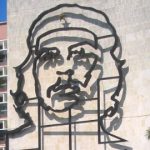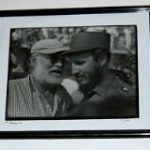- The Gift of Cuba
- Havana
- Pets
- Transportation
- Spanish Classes
- Tourists and the People They Attract
- Fidel, Che and Jose Marti
- Money
- Economics, Wealth and Poverty
- Food, Water and the Hotel
- Health and Education
- The Arts
- Looking Back
Fidel, Che and Jose Marti

To my surprise, the face most seen on walls, shirts and buttons is Ernesto “Che” Gueverra and not Fidel Castro. Che was a good friend of Castro’s and died a martyr fighting in Bolivia after being a major player in the Revolution in Cuba. One of our resource people was part of the team who found his remains thirty years after he was killed. The body had been buried in the Bolivian jungle for thirty years. When he was killed, the Cubans only knew he was dead, but not what had happened to his body. Our speaker was an agronomist. His job on the team was to use recently developed instruments to detect a possible decayed body underground. He had to calibrate them in a cemetery, and then used them in the places where there were likely depressions in the ground, found after other team members interviewed local people who might have remembered where Che could have been buried. The body was finally found and returned to his native country, Argentina.
Fidel Castro keeps a low profile. He is everywhere in spirit, but took on an air of mystery when references to him were hushed and guarded. Castro made overtures to the US for support soon after the revolution, and only turned to the Communist countries for help after being rebuffed. He was naïve to think the US would welcome him after he had ousted a US favorite leader. After Batista left, the US declared an embargo to punish Castro which was condemned years ago by the United Nations in a resolution that has been ignored by the US. The pressure is increasing in Congress to end the embargo contrary to actions of an administration courting the wealthy Miami Cuban population.

The people we spoke to seemed reluctant to use Castro’s name when referring to him. Rather, they said, “Cuba” this, and “Cuba” that when I could easily substitute Castro’s name. When asked about succession, the two people I asked about who would follow him were not worried. They have faith that there is something in place for when he is not available. I did sense hesitation from the several people we grilled about more sensitive political matters. I can admire the priorities Cuba has set, but the methods for implementation are harsh. We noticed the pervasive police when we walked through the park near the hotel. They checked identity papers of Cubans there, usually young men. Cubans are not free to move about the country, and anyone caught in Havana without the proper papers is sent home. We knew that many prisoners were political dissidents, but these were not discussed. Stories of how Castro has been able to foil rebels in his own inner circle are well documented.
We heard the name of Jose Marti, the Father of Cuba, in speeches and saw his name on buildings and streets. He left Cuba in 1870 at the age of sixteen, exiled for his separatist views. Sent to Spain, he developed his thoughts through his writings and rallied Cubans outside of Cuba to support the overthrow of the Spanish regime. He returned to his homeland for the last time in 1895, where he died in battle soon after as the war for independence began.
In 1898, the US joined the Cubans in their war for independence from Spain, famous for the participation of Teddy Roosevelt. Cuba was able to throw off the Spanish dominance only to find ready to assume the role.
Marti is said to be one of the most profound writers of the 19th Century. I might guess his standing is similar to our Thomas Jefferson. Castro refers to his ideas often and can quote from him at length. However, Marti supported national self-determination through democracy and individual human rights, points that Castro’s detractors use to strengthen their opposition to his reforms. Tourists do not hear these voices of dissent inside the country.